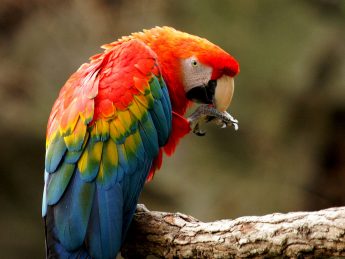Introduction
Quick Navigation
Parrots are classified in kingdom Animalia, phylum Chordata, class Aves, order Psittaciformes, and family Psittacidae. This is just the basic biological classification of parrots, and there may be few or several subdivisions in any one level. For example, there are three subfamilies within the family level. Also, about some 350 species of parrots are known to scatter across the world landscape. Parrots are native to the subtropical and tropical dry forests, moist lowlands, arid savannas, and dry shrubs of the Southern Hemisphere. They are abundant in Northern Argentina, Paraguay, Bolivia, Brazil, New Zealand, Australia, New Guinea, and Mexico, and Madagascar, to name a few. Parrots are adapted to almost all climatic types and environment. However, most parrots prefer warm climates. Male parrots may look similar to or slightly different from female parrots.
Characteristics of Parrots
Most parrots are monogamous while a few ones are polygamous. Their feet comprise four digits; two of which face forward and two face backward. Baby parrots are normally jointly nurtured by both parents. Parrots have ability to recognize humans and also to mimic human voices. They are sociable birds that form flocks comprising between 20 and 30 individuals. They are incredibly beautiful birds whose plumage may be made of two or more colors. The upper mandibles of parrots’ bills curve downwards.
Anatomy and structural adaptations of Parrots
The external anatomy of parrots like other birds comprises of a pair of wings, used for flying; a bill, whose upper mandible curves downwards; and beautifully-colored plumage. However, in terms of internal structure parrots have intrinsic muscle, and remain the only avian population that have tongues with intrinsic muscle. Some species of parrots lack preen in their digestive systems, and galls too are often absent.
Parrots have several structural adaptations. They have well-developed adaptation for feeding; they use their strong bills, digits, and claws to break several nuts in their natural habitats. Their four digits, each pair pointing in different direction are a strong adaptation for parrots to maintain stable grips on trees while feeding and climbing. In addition to this, jaws of parrots are so sturdy that they use them to break nuts in order to get the seeds inside. Parrots also have well-developed eyesight that enables them to sight an impending predator or intruder from some distance away. Their effective beaks are also used for self-defense. Parrots use their plumage as a protective device from heavy tropical rainfall while they hide beneath dense vegetal cover. The vibrant plumage of parrots enable their mates to notice them whereas it makes them look like flowers to an impending predator. Even flocking is an adaptation to scare away an imminent predator.
Feeding Habits and Lifestyle of Parrots
Parrots are mainly herbivores, that is seeds, nuts, and vegetation are their favorites. However, when their favorite foods are not available, parrots feed on other creatures including insects, bugs, and warms. Sometimes also, they eat flesh. Most parrots keep single mates for their lifetime although a few species keep more than one mates. After mating, female parrots lays her eggs in nesting locations such as sides of cliffs, old termite mounds or in tree cavities, ground tunnels or rock cavities. A female parrot usually lays between 2 to 8 eggs per breeding episode. Their eggs are usually incubated for 18 or 30 days before they can hatch. When hatched, baby parrots are blind and remain so for two weeks. They usually depend on food supplies from either parent. It usually takes between one to four years for a parrot to grow to maturity. They can be aggressive when threatened and have long life-expectancy. The longest known parrot that ever lived was 42 years old!
How long can Parrots Live
Gray Parrots. This species is scientifically known as Psittacus erithacus, otherwise known as Congo African Gray Parrot. It is one of the most talented talking or mimicking parrot of the Old World. It is classified in the Family Psittacidae. People often believe that Timneh Parrots are descendants of the Gray Parrot. They are popular for their excellent aptitude for everyday vocabularies. They have an average life span of 23 years in the wild.
Hyacinth Macaw Parrots. This is known scientifically as Anodorhyncus hyacinthinus. The species is native to eastern and central South America. In spite of its large body size, it is the only species of all macaw species that can fly. Members of this species are colored cobalt blue. They can live up to 50 years in the wild.
Blue-and-Yellow Macaw Parrots. This species of parrots is known for its blue-colored backsides and yellow-colored undersides, blended with a hue of green on its head. Its scientific name is Ara ararauna. It is native to South America. And can live for 50 years or more, depending on whether they live in the wild or captivity.
Scarlet Parrots. These are parrots colored red and yellow with a narrow hue of yellow in the middle. Their scientific name is Ara macaw, and are native to tropical Central and South America. They are large, Neotropical parrots. Their lifespan range between 50 years and 75 years depending on whether they are living in the wild or in captivity.
Eclectus Parrots. They are known as Eclectus roratus. They are native to Maluku Islands, New Guinea, Sumba, and Australia. They may live longer than 50 years in captivity but their lifespan in the wild range between 20years and 30years. However, some people speculate that their lifespan may be shorter in captivity. They send loud, high-pitched screeches to mates in the wild. They have predominant green to yellow color with hue of red and blue on their undersides.
Sun Conure. Their scientific name is Aratinga solstitialis native to northeastern South America. These vibrantly-colored, yellow parrots have medium-sized bodies. This color abruptly changes to green hue toward their hind parts. Male and female members are similar in appearance. They can live up to between 15years and 30years in captivity.
Conclusion
Parrots are incredibly wonderful birds in terms of their feeding, sociability, intelligence, and communication ability with humans. They are very diverse in kinds and well adapted to a wide range of habitats. Their lifespan is highly variable from one species to another. However, many of their species are threatened and this calls for the development of urgent conservation strategies in order to prevent them from going to extinction.

